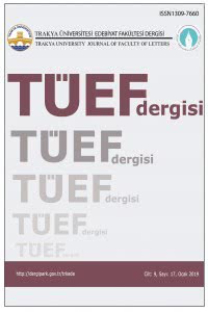Translator, Traitor: In Search of Pound’s Poetics in Turkish Translations of ‘Canto I’
imajizm, Kantolar, Ezra Pound, İlhan Berk, Efe Murad, şiir çevirisi
Translator, Traitor: In Search of Pound's Poetics in Turkish Translations of 'Canto I'
imagism, The Cantos, Ezra Pound, İlhan Berk, Efe Murad, verse translation,
___
- ALDINGTON, Richard (1915), “The Poetry of Ezra Pound” in The Egoist: An Individualist Review. Vol II, No. 5. (May, 1915), 71-72.
- DENNETT, Daniel, C, (1991), Consciousness Explained. Back Bay Books, New York.
- FIRCHOW, Peter Edgerly (1981), “Ezra Pound’s Imagism and the Tradition”. Comparative Literature Studies, Sep., 1981, Vol. 18, No. 3, Papers of the Seventh Triennial Meeting of the American Comparative Literature Association (Sep., 1981), 379-385. https://www.jstor.org/stable/40246277
- HOLMAN, Hugh C. (1980), “Canto” A Handbook to Literature. Bobbs-Merrill Education, 66.
- HOLMES, James S. (1970), “Forms of Verse Translation and the Translation of Verse Form” in Ed. James S. HOLMES, The Nature of Translation. Publishing House of the Slovak Academy of Sciences, Bratislava, 91-105.
- HULME, Thomas Ernest (1994a), “Notes on Language and Style” in Ed. Karen CSENGERI, The Collected Writings of T.E. Hulme. Clarendon Press, Oxford, 23-46.
- _______ (1994b), “A Lecture on Modern Poetry” in Ed. Karen CSENGERI, The Collected Writings of T.E. Hulme. Clarendon Press, Oxford, 49-57.
- MARTIN, Wallace (1953), “The Sources of the Imagist Aesthetics” PMLA, Mar., 1970, Vol. 85, No. 2 (Mar., 1970), 196-204. https://www.jstor.org/stable/1261393
- MONRO, Harold (1915), “The Imagists Discussed” in The Egoist: An Individualist Review. Vol II, No. 5. (May, 1915), 77-80.
- OLSEN, Flemming (2008), “Chapter 1: Imagism” in Between Positivism and T.S. Eliot: Imagisim and T.E. Hulme. University Press of Southern Denmark, Odense, 11-22.
- POUND, Ezra (1911), “I Gather the Limbs of Osiris” in The New Age: A Weekly Review of Politic, Literature and Art. Vol X, No. 5. (November 30, 1911), 107.
- _______ (1935a). “A Retrospect” in Ed. Thomas Stearns Eliot, Literary Essays of Ezra Pound. New Directions, New York, 3-14.
- _______ (1935b). “How to Read” in Ed. Thomas Stearns Eliot, Literary Essays of Ezra Pound. New Directions, New York, 15-41.
- _______ (1983) Seçme Kantolar. Trans. İlhan BERK, Yazko, İstanbul, 35-37.
- _______ (2020) Kantolar. Trans. Efe MURAD. Yapı Kredi Yayınları, İstanbul, 9-11.
- “Preface” (1915), in Some Imagist Poets: An Anthology. Houghton Mifflin Company, Boston, v-viii.
- TERREL, Carroll, F. (1980), “Canto I” in A Companion to the Cantos of Ezra Pound. University of California Press, Berkeley, 1-4.
- XIE, Ming (1999), “Pound as Translator” in Ed. Ira B. NADEL, The Cambridge Companion to Ezra Pound. Cambridge University Press, Cambridge, 204-223.
- ISSN: 1309-7660
- Yayın Aralığı: 2
- Başlangıç: 2011
- Yayıncı: -
Translator, Traitor: In Search of Pound’s Poetics in Turkish Translations of ‘Canto I’
Horezm Türkçesi ile Yazılan Sirâcü’l-Kulûb’da Benzetme ve Ölçü Unsurları
Yunanistan’ın I. Dünya Savaşı Deneyimine Postyapısalcı Bir Bakış: Söylem-Tarihsel Yaklaşım
Hopkinson Ressamı Üzerine Yeni Bir Değerlendirme
Şiirde Metinlerarasılığın Bir Türü: Geçişkenlik Örüntüsü
Doğu Trakya Buluntusu Savunma ve Saldırı Gereçleri
The Feminist Mother Figure in the Secret Diary of Adrian Mole Aged 13 ¾
A Hegelian Dialectic Reading of Oscar Wilde’s The Picture of Dorian Gray
